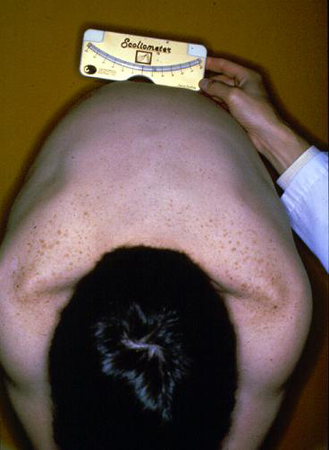School screening
Traditionally, school screening programes have been widely instituted in many areas of the world in order to identify scoliosis at an early stage and thus avoid surgical treatment that may be necessary following later presentations. These programmes are typically part of a routine annual physical examination undertaken between 10 and 12 years of age.
However, in order for scoliosis screening to be justified, an effective early treatment must be available. Previously there was borderline evidence regarding the efficacy of brace treatment, with many experts questioning the cost-effectiveness of scoliosis screening.[40]Yawn B, Yawn RA. Efficacy of school scoliosis screening. Orthopedics. 2001 Apr;24(4):317.
http://www.ncbi.nlm.nih.gov/pubmed/11332956?tool=bestpractice.com
[41]Yawn BP. School-screening for scoliosis. A prospective epidemiological study in northwestern and central Greece. J Bone Joint Surg Am. 1998 Aug;80(8):1244.
http://www.ncbi.nlm.nih.gov/pubmed/9730134?tool=bestpractice.com
[42]Yawn BP. Reassessing scoliosis screening: new definitions, new criteria. Adm Radiol J. 2000;19(8):14-7.
http://www.ncbi.nlm.nih.gov/pubmed/11185317?tool=bestpractice.com
[43]Yawn B, Yawn RA. The estimated cost of school scoliosis screening. Spine. 2000 Sep 15;25(18):2387-91.
http://www.ncbi.nlm.nih.gov/pubmed/10984793?tool=bestpractice.com
Additionally, one systematic review by the US Preventive Services Task Force found insufficient evidence to assess the benefits or harm of screening for AIS.[30]US Preventive Services Task Force., Grossman DC, Curry SJ, et al. Screening for adolescent idiopathic scoliosis: US Preventive Services Task Force recommendation statement. JAMA. 2018 Jan 9;319(2):165-72.
https://www.doi.org/10.1001/jama.2017.19342
http://www.ncbi.nlm.nih.gov/pubmed/29318284?tool=bestpractice.com
On the other hand, the Scoliosis Research Society recommends routine screening for school- aged children, citing findings from the BrAIST (Bracing in Adolescent Idiopathic Scoliosis Trial) trial, which better elucidates the efficacy of bracing in AIS.[44]Hresko MT, Talwalkar V, Schwend R, et al. Early detection of idiopathic scoliosis in adolescents. J Bone Joint Surg Am. 2016 Aug 17;98(16):e67.
http://www.ncbi.nlm.nih.gov/pubmed/27535448?tool=bestpractice.com
[45]Weinstein SL, Dolan LA, Wright JG, et al. Effects of bracing in adolescents with idiopathic scoliosis. N Engl J Med. 2013 Oct 17;369(16):1512-21.
https://www.doi.org/10.1056/NEJMoa1307337
http://www.ncbi.nlm.nih.gov/pubmed/24047455?tool=bestpractice.com
Despite this doubt, screening programmes have helped to increase the awareness of scoliosis among paediatricians and primary care physicians. Additionally, many experts feel that screening programmes provide the opportunity for early detection of scoliosis in at-risk populations.[46]Lonstein JE. Why school screening for scoliosis should be continued. Spine. 1988 Oct;13(10):1198-200.
http://www.ncbi.nlm.nih.gov/pubmed/3061027?tool=bestpractice.com
[47]Fong DY, Lee CF, Cheung KM, et al. A meta-analysis of the clinical effectiveness of school scoliosis screening. Spine (Phila Pa 1976). 2010 May 1;35(10):1061-71.
http://www.ncbi.nlm.nih.gov/pubmed/20393399?tool=bestpractice.com
[48]Sabirin J, Bakri R, Buang SN, et al. School scoliosis screening programme-a systematic review. Med J Malaysia. 2010 Dec;65(4):261-7.
https://www.e-mjm.org/2010/v65n4/Scoliosis_Screening.pdf
http://www.ncbi.nlm.nih.gov/pubmed/21901941?tool=bestpractice.com
[49]Scoliosis Research Society. Position statement - screening for the early detection for idiopathic scoliosis in adolescents. Sept 2015 [internet publication].
https://www.srs.org/about-srs/news-and-announcements/position-statement---screening-for-the-early-detection-for-idiopathic-scoliosis-in-adolescents
Adams' forward bend test
Forward bending at the waist (viewed from anterior, posterior, and lateral aspects) provides a good perspective for identifying thoracic, thoracolumbar, or lumbar paraspinal and thoracic cavity prominences (which result from abnormal vertebral rotation as well as a combination of abnormal spinal curvature in the coronal and sagittal planes). Bending forward accentuates paraspinal and rib prominences, suggestive of a diagnosis of scoliosis.[1]Parent S, Newton PO, Wenger DR. Adolescent idiopathic scoliosis: etiology, anatomy, natural history, and bracing. Instr Course Lect. 2005;54:529-36.
http://www.ncbi.nlm.nih.gov/pubmed/15948477?tool=bestpractice.com
[2]Yaszay B, Newton PO. Idiopathic scoliosis. In: Weinstein SL, Flynn JM, Crawford HA, eds. Lovell and Winter's Pediatric Orthopaedics. 8th ed. Philadelphia: Wolters Kluwer, 2021:659-720.
This is the hallmark examination finding that leads to a suspicion of scoliosis during screening evaluation. A positive result is observation of an asymmetric paraspinal prominence. The presence of an asymmetric scapular prominence may suggest an upper thoracic curve.[34]Grossman TW, Mazur JM, Cummings RJ. An evaluation of the Adams forward bend test and the scoliometer in a scoliosis school screening setting. J Pediatr Orthop. 1995 Jul-Aug;15(4):535-8.
http://www.ncbi.nlm.nih.gov/pubmed/7560050?tool=bestpractice.com
This test has been shown to have reasonable intra- and interobserver reliability.[1]Parent S, Newton PO, Wenger DR. Adolescent idiopathic scoliosis: etiology, anatomy, natural history, and bracing. Instr Course Lect. 2005;54:529-36.
http://www.ncbi.nlm.nih.gov/pubmed/15948477?tool=bestpractice.com
[2]Yaszay B, Newton PO. Idiopathic scoliosis. In: Weinstein SL, Flynn JM, Crawford HA, eds. Lovell and Winter's Pediatric Orthopaedics. 8th ed. Philadelphia: Wolters Kluwer, 2021:659-720.
Scoliometer measurement
Although not routinely undertaken in the general population, scoliometer measurement allows quantification of the paraspinal prominences found by Adams' forward bend test.
A positive result is one of >5° at any paraspinal prominence (thoracic or lumbar). Although scoliometer measurements do not exactly represent Cobb angle measurements from plain film radiographs, the 2 values may correlate with one another. In general, scoliometer measurements of 5° and 7° correspond to a measured Cobb angle of approximately 10° and 20°, respectively.[35]Ashworth MA, Hancock JA, Ashworth L, et al. Scoliosis screening. An approach to cost/benefit analysis. Spine. 1988 Oct;13(10):1187-8.
http://www.ncbi.nlm.nih.gov/pubmed/3144755?tool=bestpractice.com
[36]Bunnell WP. An objective criterion for scoliosis screening. J Bone Joint Surg Am. 1984 Dec;66(9):1381-7.
http://www.ncbi.nlm.nih.gov/pubmed/6501335?tool=bestpractice.com
This correlation makes scoliometer measurements useful as they represent commonly agreed-upon cut-off points used to direct treatment decisions.
It has been shown that a scoliometer reading of 5° has a sensitivity of 100% and a specificity of 47% for the detection of adolescent idiopathic scoliosis. Based on this data, a patient with a scoliometer reading of <5° does not warrant further evaluation with plain film radiographs. However, a scoliometer reading of 7° has a sensitivity of 83% and a specificity of 86% and thus warrants further evaluation with plain film radiographs and referral to a spinal deformity specialist.[35]Ashworth MA, Hancock JA, Ashworth L, et al. Scoliosis screening. An approach to cost/benefit analysis. Spine. 1988 Oct;13(10):1187-8.
http://www.ncbi.nlm.nih.gov/pubmed/3144755?tool=bestpractice.com
[36]Bunnell WP. An objective criterion for scoliosis screening. J Bone Joint Surg Am. 1984 Dec;66(9):1381-7.
http://www.ncbi.nlm.nih.gov/pubmed/6501335?tool=bestpractice.com
[Figure caption and citation for the preceding image starts]: Scoliometer measurement of a right thoracic prominenceWeinstein SL, et al. Adolescent idiopathic scoliosis. Lancet. 2008;371:1527-1537. Used with permission [Citation ends].
